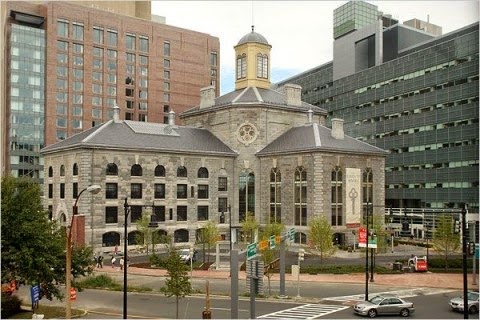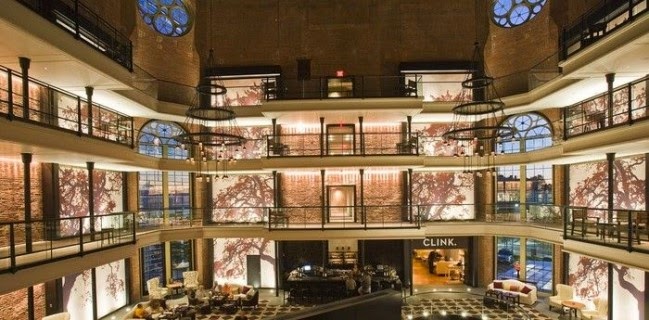The luxurious 298-room Liberty Hotel is part of the Starwood Luxury Collection. Its creation from a prison is one of the most creative and unusual conversions of our time. It was converted in 2007 from the Charles Street Jail for $150 million. Completed in 1851, the jail was designed by Gridley James Fox Bryant, Boston’s most famous architect. Satisfaction with his work was so high that of the 152 buildings he designed that were destroyed by the Great Fire of 1872, he was given commissions to rebuild 110 of them.
The landmark jail was built between 1848 and 1851 with the advice of the humanitarian prison reformer Rev. Louis Dwight who designed it in accordance with the English Auburn Plan. The original jail was built in the form of a cross with four wings of Quincy granite extending from a central octagonal rotunda with a 90-foot-tall atrium. The wings allowed segregation of prisoners by sex and category of offense. Thirty arched windows, each 33 feet high, provided ventilation and natural light. The original jail contained 220 granite cells, each 8 feet by 10 feet. Over its 140 year life, the jail had a number of famous inmates: Sacco and Vanzetti, Mayor James Michael Curley, Malcolm X, women suffragettes and World War II prisoners from the German submarine Unterseeboot 234.
 |
| The hotel today |
 |
| Hotel lobby |
In 1973, after 122 years of housing some of Boston’s most notorious criminals, prisoners revolted because of poor living conditions and ultimately the jail was declared unfit and in violation of the inmates’ constitutional rights. On Memorial Day weekend in 1990, the last prisoners were moved to the new Suffolk County Jail. In 1991, Massachusetts General Hospital (MGH) acquired the old prison and sought proposals for its reuse, requiring that significant elements of the building be preserved. In 2001, Carpenter & Company was designated the developer of the project, and entered into a lease agreement with MGH for the land and the jail itself.
The brilliant transformation of the site into a hotel was the work of developer Richard L. Friedman and a team of designers and architects from the Cambridge Seven Associates and Ann Beha Architects. They collaborated with historians and conservationists from the Massachusetts Historical Commission, the Boston Landmarks Commission, the National Park Service and the Boston Redevelopment Authority to ensure that the end result was a thoughtful balance between architectural preservation and a dynamic new use.
Drawn to the building’s dramatic spatial qualities, the team tapped Bryant’s original architectural drawings to ensure adherence to his creative vision for the cruciform-shaped building. Owing much of its character to the powerful Romanesque and Renaissance forms used in its design, the building consists of an octagonal central building featuring four circular wood “ocular” windows and four radiating wings, each with large three-story arched windows highlighted by articulated wedge-shaped, stone “voussoirs” characteristic of French design. At the time of the original construction, the windows were thought to yield light “four times as great as that in any prison yet constructed.”
After the renovations, the jail’s granite exterior and expansive, light-filled interiors remain largely unchanged. Soaring 90 feet, the jail’s central atrium was preserved to form the core of the new hotel. It features the building’s trademark windows and historic catwalks. The former exercise yard is now the hotel’s landscaped courtyard that has become one of the beloved “hidden gardens” of the Beacon Hill neighborhood. While most of the 298 guestrooms are in a new tower, 18 are in the original jail, connected by catwalk-like terraces that prison guards once patrolled.
In 2013, the Liberty Hotel was acquired by LaSalle Hotel Properties through a $170 million joint venture with the hotel’s original developer, Carpenter & Company.
This article has been excerpted with the author’s permission from the book, “Built To Last: 100+ Year-Old Hotels East of the Mississippi,” AuthorHouse 2013. The author, Stanley Turkel, is a recognized authority and consultant in the hotel industry. He operates his hotel, hospitality and consulting practice specializing in asset management, operational audits and the effectiveness of hotel franchising agreements and litigation support assignments. Clients are hotel owners, investors and lending institutions.
www.stanleyturkel.com






















